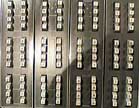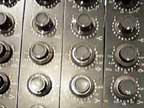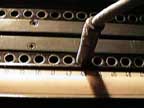NEVE 4792 CONSOLE
A Technical History of the console by Geoff Tanner
(former head of the Electrical Drawing Office, Custom Sales Engineer,
Special Orders Manager, Spares Orders Manager,
and Special Projects Manager of Neve Electronics International)
For a great tale of this amazing Neve console we need to take
a time machine back 20 years to late 1977. Four years had passed
since Rupert Neve and Company were acquired by the Bonochord group
of companies (later to be renamed Energy Services and Equipment)
and Rupert has subsequently left the company he had founded to
form another called Nevenco, based in Hills Road, Cambridge. I
recall seeing advertisements for Nevenco consoles in Studio Sound,
and they appeared to be small broadcast style consoles.
 Back at the Neve factory major changes had taken place with a
complete re- styling of the product range into “New Appearance
Design” (NAD). The RAF Blue Gray paint work was replaced with
EXTRA Dark Sea Gray, the Marconi control knobs were replace with
a custom Neve designed version, and all the lettering changed
from uppercase to lower case. The circle of dots around the control
knobs also was changed to a divided part circle. An easy way to
establish a module’s paint color is to check if the module number
has a 3 prefix. A 1084 module is RAF Blue Gray, a 31084 is NAD
Extra Dark Sea Gray.
Back at the Neve factory major changes had taken place with a
complete re- styling of the product range into “New Appearance
Design” (NAD). The RAF Blue Gray paint work was replaced with
EXTRA Dark Sea Gray, the Marconi control knobs were replace with
a custom Neve designed version, and all the lettering changed
from uppercase to lower case. The circle of dots around the control
knobs also was changed to a divided part circle. An easy way to
establish a module’s paint color is to check if the module number
has a 3 prefix. A 1084 module is RAF Blue Gray, a 31084 is NAD
Extra Dark Sea Gray.
 Current console production at the time was 8058’s, 68’s and 78’s
with an ever increasing range of smaller 53 and 54 broadcast consoles.
Integrated circuits were just beginning to appear in previously
“all discrete” consoles. Meanwhile, in the very depths of the
Neve sales machine, a project was stirring and the outline specification
of a radical custom console was being finalized. The customer
was AIR Recording Studios and the destination for the finished
console was the idyllic West Indies island of Montserrat.
Current console production at the time was 8058’s, 68’s and 78’s
with an ever increasing range of smaller 53 and 54 broadcast consoles.
Integrated circuits were just beginning to appear in previously
“all discrete” consoles. Meanwhile, in the very depths of the
Neve sales machine, a project was stirring and the outline specification
of a radical custom console was being finalized. The customer
was AIR Recording Studios and the destination for the finished
console was the idyllic West Indies island of Montserrat.
The 52 Channel frame, 24 track console was the brainchild of three
of the best respected names in pro audio, George Martin of AIR,
Geoffrey Emerick and Rupert Neve. Also involved in the design
was Geoff Watts (with Rupert since his early days at the Priesthaus)
and the project engineer was Graham Wood.
The desk (serial number A4792), although outwardly similar to
an 8078, was a totally new concept taking some radical design
departures from the more conventional Neve consoles. First, the
console ran from +/-15 volt rails and was designed around the
TDA1034 operational amplifier IC, later to become the NE5534.
The custom wound audio transformers differed from stock Neve product
by their toroidally wound construction.
The 31106 equalizer might appear to be a close cousin to the 8078’s
31105 but the similarities end at the paint finish and choice
of knobs! The equalizer frequencies for the 31106 were decided
as the optimum choice by Martin and Neve and were quite different
to those chosen for the 31105. Remove the module side covers and
the IC loaded motherboard appeared to be missing a mic input stage!
Not so, this was the first Neve console to have remote mounted
mic pre’s. The new 34427 modules were mounted in racks in the
studio and their gain set by a variable current source linked
to the 31106’s mic gain switch. The idea was to eliminate the
deficiencies caused by long mic leads (and was reborn in early
Focusrite modules, as well as a recent AMEK product).
 The 32436 Aux routing unit offered six mono aux sends plus 2 stereo
pairs (quad) and used an output circuit with a toroidal transformer
driven by an IC amplifier and discrete transistor pair. The passive
32424 Group Switching modules were lifted straight out of an 8078
design, one of the few similarities!
The 32436 Aux routing unit offered six mono aux sends plus 2 stereo
pairs (quad) and used an output circuit with a toroidal transformer
driven by an IC amplifier and discrete transistor pair. The passive
32424 Group Switching modules were lifted straight out of an 8078
design, one of the few similarities!
One nice feature (not exclusive to Neve consoles, of course) was
their wide frequency response. You can wind a 1073 up to around
50khz and still only be around 3db down (eat your harts out you
44.1 clocked digital fans!) but this AIR Montserrat console had
a response approaching dc to light!
 A slight exaggeration, of course, but the response had to be better
than 1 db down at 40khz and no serious roll off until around 100Khz.
Much discussion can be held on the merits of a response like this,
especially in light of my teasing of the digital brigade with
their barn door filters around 20khz, but the fact remains that
many musical instruments have harmonics that pass above the 20khz
region and there ar those, including George Martin, who can detect
/ feel a change in the quality of the fundamental sound if that
harmonic is altered or removed. I'm talking soft classical music
here and not head-banging rock n’ roll!
A slight exaggeration, of course, but the response had to be better
than 1 db down at 40khz and no serious roll off until around 100Khz.
Much discussion can be held on the merits of a response like this,
especially in light of my teasing of the digital brigade with
their barn door filters around 20khz, but the fact remains that
many musical instruments have harmonics that pass above the 20khz
region and there ar those, including George Martin, who can detect
/ feel a change in the quality of the fundamental sound if that
harmonic is altered or removed. I'm talking soft classical music
here and not head-banging rock n’ roll!
Three years later, in early 1981, AIR placed an order for a virtual
repeat of the Montserrat console (A7971) for use in their studio
in Oxford Street, London. Around 1986 Rupert Neve launched Focusrite
and manufactured a “sidecar” of Focusrite equalizer channels to
fit against this later console. I note a lot of discussion on
the web concerning the merits of Neve eq versus early Focusrite.
Here, at AIR Recording, now based at Lyndhurst Hall, London NW3,
is an opportunity to make a subjective comparison!
 The original A4792 Montserrat console was brought back to England
and consequently sold to A&M Records in Hollywood where a 12 channel
console extension was added. The third console (the one that ended
up at Atlantic Studios in NY) was eventually sold to Bryan Adams
for his studio in Vancouver. All three consoles are still making
hit records two decades after they were built.
The original A4792 Montserrat console was brought back to England
and consequently sold to A&M Records in Hollywood where a 12 channel
console extension was added. The third console (the one that ended
up at Atlantic Studios in NY) was eventually sold to Bryan Adams
for his studio in Vancouver. All three consoles are still making
hit records two decades after they were built.
Geoff Tanner
30 May 1997
Phoenix Audio International
Hollywood, USA and Stevenage, UK
Email = phoenixaudio@earthlink.net
ps . I acknowledge that references to Neve refer to Neve Electronic
Laboratories Ltd at the time of the occurrences detailed and the
company is now called AMS Neve plc.
 Back at the Neve factory major changes had taken place with a
complete re- styling of the product range into “New Appearance
Design” (NAD). The RAF Blue Gray paint work was replaced with
EXTRA Dark Sea Gray, the Marconi control knobs were replace with
a custom Neve designed version, and all the lettering changed
from uppercase to lower case. The circle of dots around the control
knobs also was changed to a divided part circle. An easy way to
establish a module’s paint color is to check if the module number
has a 3 prefix. A 1084 module is RAF Blue Gray, a 31084 is NAD
Extra Dark Sea Gray.
Back at the Neve factory major changes had taken place with a
complete re- styling of the product range into “New Appearance
Design” (NAD). The RAF Blue Gray paint work was replaced with
EXTRA Dark Sea Gray, the Marconi control knobs were replace with
a custom Neve designed version, and all the lettering changed
from uppercase to lower case. The circle of dots around the control
knobs also was changed to a divided part circle. An easy way to
establish a module’s paint color is to check if the module number
has a 3 prefix. A 1084 module is RAF Blue Gray, a 31084 is NAD
Extra Dark Sea Gray. Current console production at the time was 8058’s, 68’s and 78’s
with an ever increasing range of smaller 53 and 54 broadcast consoles.
Integrated circuits were just beginning to appear in previously
“all discrete” consoles. Meanwhile, in the very depths of the
Neve sales machine, a project was stirring and the outline specification
of a radical custom console was being finalized. The customer
was AIR Recording Studios and the destination for the finished
console was the idyllic West Indies island of Montserrat.
Current console production at the time was 8058’s, 68’s and 78’s
with an ever increasing range of smaller 53 and 54 broadcast consoles.
Integrated circuits were just beginning to appear in previously
“all discrete” consoles. Meanwhile, in the very depths of the
Neve sales machine, a project was stirring and the outline specification
of a radical custom console was being finalized. The customer
was AIR Recording Studios and the destination for the finished
console was the idyllic West Indies island of Montserrat.  The 32436 Aux routing unit offered six mono aux sends plus 2 stereo
pairs (quad) and used an output circuit with a toroidal transformer
driven by an IC amplifier and discrete transistor pair. The passive
32424 Group Switching modules were lifted straight out of an 8078
design, one of the few similarities!
The 32436 Aux routing unit offered six mono aux sends plus 2 stereo
pairs (quad) and used an output circuit with a toroidal transformer
driven by an IC amplifier and discrete transistor pair. The passive
32424 Group Switching modules were lifted straight out of an 8078
design, one of the few similarities! A slight exaggeration, of course, but the response had to be better
than 1 db down at 40khz and no serious roll off until around 100Khz.
Much discussion can be held on the merits of a response like this,
especially in light of my teasing of the digital brigade with
their barn door filters around 20khz, but the fact remains that
many musical instruments have harmonics that pass above the 20khz
region and there ar those, including George Martin, who can detect
/ feel a change in the quality of the fundamental sound if that
harmonic is altered or removed. I'm talking soft classical music
here and not head-banging rock n’ roll!
A slight exaggeration, of course, but the response had to be better
than 1 db down at 40khz and no serious roll off until around 100Khz.
Much discussion can be held on the merits of a response like this,
especially in light of my teasing of the digital brigade with
their barn door filters around 20khz, but the fact remains that
many musical instruments have harmonics that pass above the 20khz
region and there ar those, including George Martin, who can detect
/ feel a change in the quality of the fundamental sound if that
harmonic is altered or removed. I'm talking soft classical music
here and not head-banging rock n’ roll! The original A4792 Montserrat console was brought back to England
and consequently sold to A&M Records in Hollywood where a 12 channel
console extension was added. The third console (the one that ended
up at Atlantic Studios in NY) was eventually sold to Bryan Adams
for his studio in Vancouver. All three consoles are still making
hit records two decades after they were built.
The original A4792 Montserrat console was brought back to England
and consequently sold to A&M Records in Hollywood where a 12 channel
console extension was added. The third console (the one that ended
up at Atlantic Studios in NY) was eventually sold to Bryan Adams
for his studio in Vancouver. All three consoles are still making
hit records two decades after they were built.